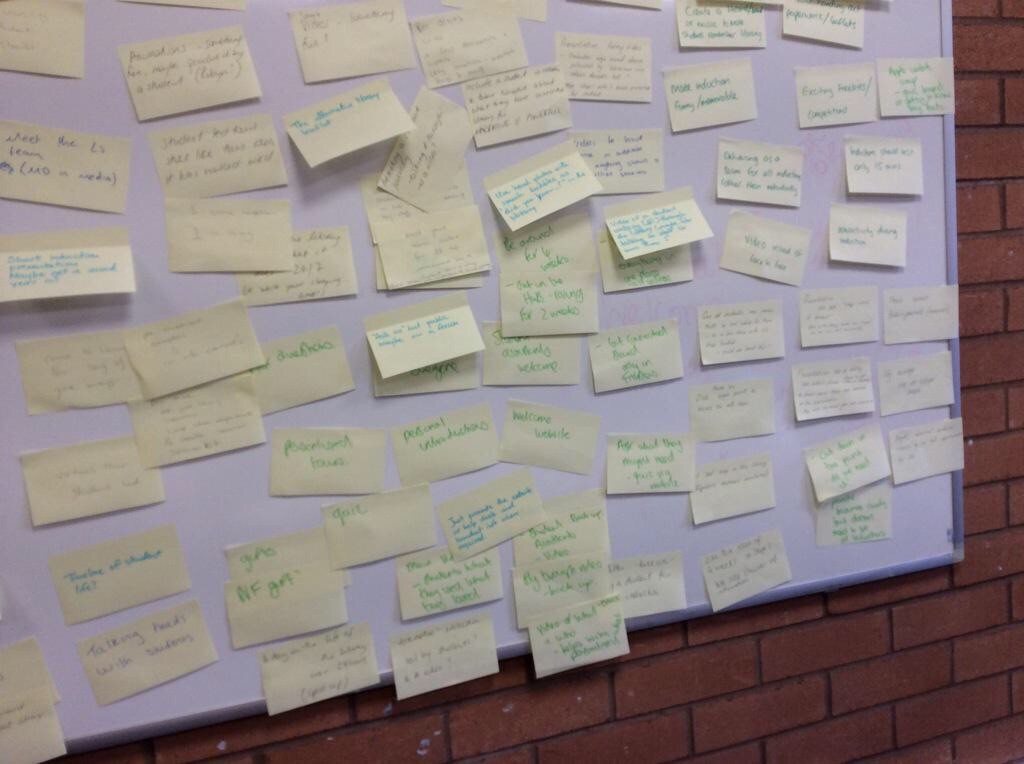With a major UK conference last month, the subject of UX in libraries is very much on the agenda. UX or usability can take a variety of forms and many of us have been engaging with the ideas, techniques and concepts of UX for the past couple of years.
Helen Jamieson and I attended a UX in Libraries conference which was held at the University of Cambridge in March and what a conference it was. We felt we were on a film set for most of the week!. It was truly international with library colleagues, anthropologists, ethnographers and web designers from all over the world there to inspire us.
We were introduced to a new concept – ideation = idea generation. It was great fun with one exercise generating well over a 100 post-it notes of ideas around improving library spaces in one of the Cambridge libraries.
 When we returned home, we decided to try out the 6-8-5 technique as a way of creating new ideas for student induction 2015. We tried it out with our staff who are on the induction planning group and then with a group of students. You’ll have to wait until September to see the results…
When we returned home, we decided to try out the 6-8-5 technique as a way of creating new ideas for student induction 2015. We tried it out with our staff who are on the induction planning group and then with a group of students. You’ll have to wait until September to see the results…
If you’re not familiar with the technique (and we weren’t) 6-8-5 is where you have 5 minutes to write 6 to 8 ideas on post-its. You share with your group, this can spark your creative juices so you repeat the exercise again with another 5 minutes – you might have new ideas or you have honed one of your original ideas or one of the teams. You do create lots of ideas but they do begin to fall into themes when you bring them together and start to discuss.
What else are we doing?
Something which was a running theme with the keynote speakers at the conference and the breakout sessions was the limitations of data. Questionnaires don’t help us find out how using a service or a library space feels to our users. With this in mind, and following the success of diary mapping student study habits on campus, next term we will be mapping and questioning how students approach an assignment. We know we don’t know enough so finding out more about the touch points with Learning Services will help us improve our service and support for students.
Three years ago as we prepared to develop new web pages for Learning Services, we dipped our toe into the water of web usability working with some prospective students who were our volunteers. The work we undertook was fascinating as we watched students find – or not find as the case maybe- the answers to some standard questions that we get asked all the time. The feedback gave us some great insights and helped us re-design some of our site – unfortunately, we can only share the videos with colleagues who were involved in the project and were named on the consent form but we are happy to talk to anyone thinking of undertaking a similar exercise.
More recently, we have been applying the same techniques to our single search tool, ‘Discover More’ observing volunteers trying to answer a number of questions using its navigation. We have been recording their experiences using screen capture software and a small team has been evaluating the results.
This month we are beginning to undertake usability of our VLE, Blackboard. We have a brand new group of students who have just started their course at Edge Hill and we are keen to develop an understanding of how intuitive new students find Blackboard, and how they find key information – timetables, announcements, course handbooks, library resources.
The conference however has inspired us to be even more pioneering. Although our ethnographic techniques will continue we will be starting to introduce a more anthropological approach to the use of library services, as well as beginning to look at UXing some of our online activities as well.
Rachel Bury
Academic Liaison Manager – Quality, Marketing and Communication
Helen Jamieson
Customer Services Manager

![image[2]](https://blogs.edgehill.ac.uk/ls/files/2015/05/image2-225x300.jpg)